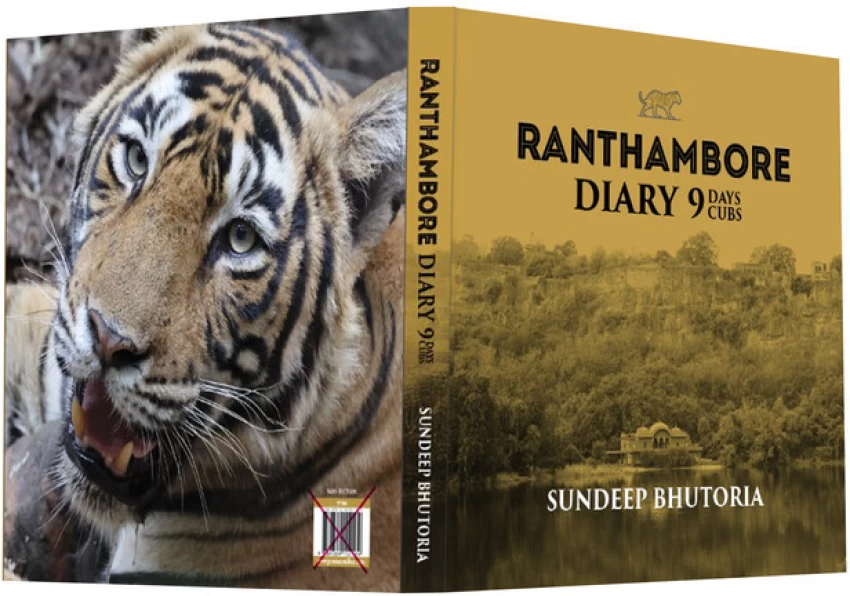Between paws and pages: A review of ‘Ranthambore Diary: 9 Days 9 Cubs’

By Rasheed Kidwai Special to The Times Kuwait
There are some books that transport you to worlds unknown, where you can hear the rustling leaves above, feel the crunch of dry twigs underfoot, and anticipate the spotting of something rare and breathtaking. Ranthambore Diary: 9 Days 9 Cubs by Sundeep Bhutoria is one such book.

“This book is dedicated to T-13,” the dedication declares at the outset, “a tigress I have never seen but every time I visit Ranthambore, the stories abound.” This sets the tone for a work that is as much about the celebrated tigers as it is about that what is left unseen — of whispered legends and of less-documented conservation efforts that make the royal Ranthambore forests a sanctuary not just for wildlife, but also for that human spirit that reveres nature.
Sundeep Bhutoria is an established author, conservationist and cultural advocate whose work spans various realms of literature and environmental awareness. Known for his engagement with wildlife conservation and cultural heritage, he has previously authored books that explore India’s biodiversity and its literary traditions. In Ranthambore Diary: 9 Days 9 Cubs, his deep-seated passion for wildlife makes itself evident through a narrative style that is simple, keen, and brimming with wonder and respect for its subject matter. His writing also combines personal observations with broader reflections on conservation and history.
Written as an epistolatory, the coffee table book takes readers through a nine-day journey in the forest, with keen documentation accompanied by chronologically laid-out pictures providing a sense of being plucked out of the noisy bustle of city life and dropped into the heart of the wild. The diary-style format lends an immediacy to the book, capturing the unpredictability of wildlife sightings and allowing the reader to experience a tiger-sighting chase in real-time, sharing the anticipations, disappointments and triumphs from each safari. From keen, watchful eyes scanning the forest for cues, picking up on indicative birdsong that signifies a looming predator in the vicinity, the exhilaration of spotting pug marks, and the collective hush that falls as the striped beast saunters into sight, the reader lives a vicarious slice of forest life in the pages of this book.
In one particularly evocative entry, Bhutoria describes an encounter with a tigress: “Riddhi crossed the path right in front of us and was calling out to her cubs to follow, but being only about five months of age and still not so accustomed to the vehicles, they would not follow their mother.”
However, the epistolary format also introduces some narrative challenges. The fragmented nature of diary entries can make certain observations feel disjointed, occasionally disrupting the book’s flow. While this format works well for conveying raw, unfiltered experiences, readers seeking a more cohesive, analytical exploration of Ranthambore’s ecosystem and conservation efforts may find it limiting.
Ranthambore Diary’s most compelling aspect is its visual appeal. Photography plays a pivotal role in shaping the narrative, as Manjari Maheshwari’s images capture the essence of Ranthambore’s landscape and its majestic inhabitants. The photographs cover a wide range of subjects, from close-up portraits of tigers that reveal their striking expressions and unique markings to panoramic shots of Ranthambore’s rugged terrain, dotted with ancient ruins and shimmering lakes. These photographs bring the forest alive, from candid moments of tiger cubs playing in the wilderness to the imposing grandeur of Jhumar Baori and Ranthambore Fort silhouetted against a fiery sunset, depicting the art that is Ranthambore.
Bhutoria himself acknowledges the power of photography in capturing fleeting moments: “Sometimes I feel that we actually miss the charm and enjoyment of a beautiful scene or adventure unfolding in front of our eyes by constantly trying to capture it with our phones and cameras,” a sentiment which is echoed throughout the book, emphasising the delicate balance between documentation and presence in the moment.
Through archival black and white photographs and anecdotes that feature in the book, Bhutoria engages with a rich history, contrasting the present-day conservation efforts with Ranthambore’s colonial past, when the region was a royal hunting ground for maharajas and British dignitaries. These images, featuring figures posing with hunted tigers, offer a sobering reminder of how perspectives on wildlife have evolved over time.
Notwithstanding its limitations in narrative cohesion and analytical depth, Ranthambore Diary: 9 Days 9 Cubs is an engrossing read that successfully captures the magic and mystery of one of India’s most celebrated tiger reserves. Its strengths lie in its deeply personal engagement with the subject matter, its historical juxtapositions, and its photographic documentation.
For those who appreciate immersive storytelling and evocative imagery, this book is a worthy addition to the growing body of literature on Indian wildlife. It is a celebration of Ranthambore’s enduring legacy and a testament to the ongoing efforts to protect its most iconic residents. As Bhutoria’s diary entries remind us, the story of Ranthambore is still being written, and every tiger sighting is both a privilege and a promise for the future of conservation.
 Mr. Rasheed Kidwai
Mr. Rasheed Kidwai
Mr. Rasheed Kidwai is a senior Indian journalist, renowned author and a visiting Fellow of Observer Research Foundation(ORF).










